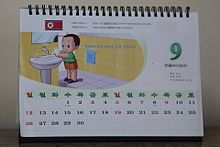Juche calendar
| Juche calendar | |
 A Juche calendar for Juche 99 (2010) | |
| Korean name | |
|---|---|
| Chosŏn'gŭl | |
| Hancha | |
| Revised Romanization | Juche ryeok |
| McCune–Reischauer | Chuch'e ryŏk |
| Juche Era | |
| Chosŏn'gŭl | |
| Hancha | |
| Revised Romanization | Juche nyeonho |
| McCune–Reischauer | Chuch'e nyŏnho |
The Juche calendar, named after the Juche ideology, was the system of year-numbering used in North Korea. It begins with the birth of Kim Il Sung, the founder of North Korea. His birth year, 1912 in the Gregorian calendar, is "Juche 1" in the Juche calendar. The calendar was adopted in 1997, three years after the death of Kim Il Sung.
History
[edit]The calendar borrows elements from two historical calendars used in Korea, the traditional system of Korean era names and the Gregorian calendar in which years are tied to the traditional birth of Jesus. In contrast to these two, the Juche calendar begins with the birth of the founder of the Democratic People's Republic, Kim Il Sung.[1]
The decree on the Juche calendar was adopted on 8 July 1997, on the third anniversary of the death of Kim Il Sung. The same decree also designated the birth anniversary of Kim Il Sung as the Day of the Sun. The birth year of Kim Il Sung, 1912 in the Gregorian calendar, became "Juche 1" in the Juche calendar.[2][3]
The calendar began to be implemented on 9 September 1997, the Day of the Foundation of the Republic.[2] On that date, newspapers, news agencies, radio stations, public transport, and birth certificates began to use Juche years.[4] The Gregorian calendar was used alongside the Juche calendar until 2022.[5] In October 2024, North Korea started to stop using the Juche calendar. On 13 October 2024, Rodong Sinmun stopped using the calendar in favour of solely using the Gregorian calendar.[6][7]
Usage
[edit]The year 1912 is "Juche 1" in the Juche calendar. There are no "before Juche" years; years before 1912 are given numbers based on the Gregorian calendar only. Ranges of years that begin before 1912 and end after it are also given in Christian calendar numbers only.[8]
Any other years after 1912 will be given in either Juche years only, or in Juche years and the corresponding year in the Christian calendar in parentheses. In material pertaining to relations with foreign countries, "the Juche Era and the Christian Era may be used on the principles of independence, equality and reciprocity."[8]
The Juche calendar is a popular souvenir among tourists visiting North Korea.[9]
Examples
[edit]| Juche year | Gregorian year | Dangun year | Event |
|---|---|---|---|
| 1 | 1912 | 4245 | Kim Il Sung's birth |
| 8 | 1919 | 4252 | March 1st Movement against Japanese rule |
| 30 | 1941 | 4274 | Kim Jong Il's birth (Soviet records) |
| 31 | 1942 | 4275 | Kim Jong Il's birth (North Korean records) |
| 34 | 1945 | 4278 | Liberation of Korea from Japanese rule |
| 37 | 1948 | 4281 | Establishment of North Korea |
| 39–42 | 1950–1953 | 4283–4286 | Korean War |
| 71 | 1982 | 4315 | Kim Jong Un's birth (North Korean records) |
| 72 | 1983 | 4316 | Kim Jong Un's birth (South Korean and U.S. records) |
| 83 | 1994 | 4327 | Kim Il Sung's death |
| 83–87 | 1994–1998 | 4327–4331 | North Korean famine (Arduous March) |
| 86 | 1997 | 4330 | Introduction of the Juche calendar |
| 100 | 2011 | 4344 | Kim Jong Il's death |
| 112 | 2023 | 4356 | Last year |
| 113 | 2024 | 4357 | Current year |
| 114 | 2025 | 4358 | Next year |
See also
[edit]- Public holidays in North Korea
- The year numbers of the Republic of China calendar, currently used in Taiwan, match those of the Juche calendar.
- The years in Japan's Taishō era (30 July 1912 to 25 December 1926) coincided with those of the Juche calendar.
References
[edit]- ^ Andrew Logie (17 September 2012). The Answers: North Korea: How do you solve a problem like North Korea?. Marshall Cavendish International Asia Pte Ltd. p. 57. ISBN 978-981-4398-90-9.
- ^ a b Hy-Sang Lee (2001). North Korea: A Strange Socialist Fortress. Greenwood Publishing Group. p. 220. ISBN 978-0-275-96917-2.
- ^ Martin K. Dimitrov (31 July 2013). Why Communism Did Not Collapse: Understanding Authoritarian Regime Resilience in Asia and Europe. Cambridge University Press. p. 104. ISBN 978-1-107-03553-9.
- ^ "Juche era available in Korea". KCNA. 10 September 1997. Archived from the original on 3 June 2015. Retrieved 15 August 2016.
- ^ Parry, Richard (22 February 2022). "Why it's no longer 2022 in North Korea". The Times. Retrieved 11 September 2024.
- ^ Kim, Han-joo (17 October 2024). "N. Korea stops using 'juche' calendar in effort to reinforce Kim's leadership". Retrieved 17 October 2024.
- ^ https://en.yna.co.kr/view/AEN20241126006600315?section=search
- ^ a b "Rules on use of Juche Era adopted". KCNA. 25 August 1997. Archived from the original on 5 May 2015. Retrieved 31 August 2016.
- ^ 北朝鮮で高コスパ土産として人気のカレンダー3種類を徹底解析. Korea World Times (in Japanese). 31 March 2019. Retrieved 12 July 2020.
